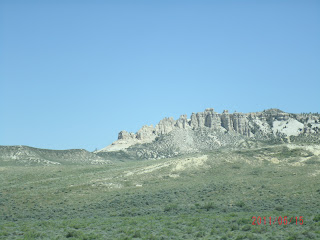While driving through Wyoming last year my husband and I talked about what it must have been like to migrate west with little more than a wagon and a dream and what visionaries those pioneers must have been...
The Homestead Act of 1862 allowed a person to claim as much
as 160 acres, with the condition that they would improve the property, live on
it for five years and pay a fee of approximately $30. Within a few short years
over 20,000 pioneers had gone west to stake their claim, and within the next
four decades a million more traveled westward to carve a life out of the vast
lands. Over two million more purchased land from the railroads, land companies,
and/or state governments. What some soon discovered was, though the land was
cheap, everything else was expensive. At average, to start a homestead took a minimum
of $1,000, translated into 2012 dollars, that would be about $25,000. This was
mainly for livestock, equipment, and seed, not building materials for a home or
food, etc.
The influx of people brought new inventions such as special
plows and equipment needed, but along with them came new costs, and on average,
less than half of the homesteaders actually succeeded.
Just as the railroad provided ways for cattle ranches to
transport their animals, it gave the farmer a way to transport grain. Soon
farmers discovered it was more profitable to grow one ‘cash’ crop, and a lot
like the cattle barons, they started accumulating large tracts of land to
increase profits, especially when John S. Pillsbury of Minneapolis perfected his
flour-milling process and the demand for grain increased.
This wave of homesteaders included women, who worked side by
side the men to pursue their dreams, and that, along with the fact in some
places there were 100 men for every 1 woman, women of the west were ‘granted’
more ‘privileges’ than those in the east. Land ownership, business ownership,
and bringing charges against people or business who wronged them, were a few of
the rights women sought and ultimately received in the west, which prompted
more eastern women to move west.
In 1890 the U.S. Census director officially proclaimed there
was no more ‘frontier’ in America.
I wish you all a blessed and happy Thanksgiving.



1 comment:
I think that first photo says it all, Lauri. Can you imagine trying to GROW things on land like that without irrigation? And that picture looks to have been taken in spring when there are hints of green.
As you know, I did a lot of research about the Homestead Acts and homesteading for my last book too, and it's no wonder so many people failed. Like everything else, the people who got there first got the best land with water sources and latecomers... didn't. All those plows carved up a lot of marginal land that not only the people couldn't make a living off of but that made for ugly payback in the Dust Bowl years.
Post a Comment